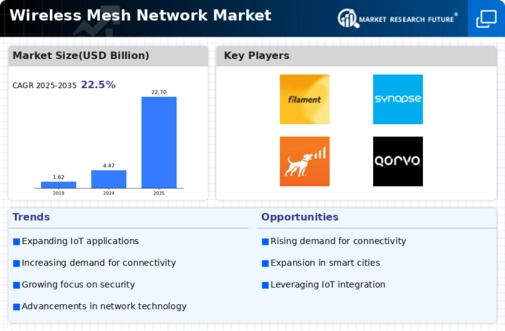Wireless Mesh Network Size
Wireless Mesh Network Market Growth Projections and Opportunities
The Wireless Mesh Network (WMN) market is influenced by several pivotal market factors that significantly impact its development and expansion. One of the primary drivers of this market is the increasing demand for robust, flexible, and scalable wireless networking solutions in diverse environments. As organizations, municipalities, and public venues seek to deploy reliable and high-performance wireless networks, there is a growing need for WMN solutions to provide seamless connectivity, extended coverage, and self-healing capabilities. This emphasis on resilient and adaptable wireless networking has propelled the growth of the market, particularly in response to the escalating demand for wireless connectivity across urban, industrial, and enterprise settings.
Moreover, the proliferation of IoT (Internet of Things) devices, smart city initiatives, and industrial automation has significantly impacted the WMN market. With the rise of IoT deployments and the need to support a multitude of connected devices, there is a heightened demand for WMN solutions that can accommodate diverse traffic patterns, manage IoT device connectivity, and facilitate data exchange across distributed environments. The market has witnessed a surge in demand for WMN technologies offering IoT device integration, edge computing support, and QoS (Quality of Service) prioritization, driven by the need to enable seamless connectivity for IoT ecosystems and industrial automation, thus contributing to the expansion of the market.
Furthermore, the evolving connectivity requirements in urban environments, public venues, and outdoor spaces have played a crucial role in shaping the WMN market. As municipalities, transportation hubs, and outdoor event venues seek to provide ubiquitous Wi-Fi access and smart city services, there is a growing need for WMN solutions that can extend wireless coverage, support high user densities, and facilitate outdoor connectivity. The demand for WMN technologies offering outdoor mesh nodes, mesh backhaul optimization, and seamless roaming capabilities has surged, driven by the imperative to enable pervasive wireless connectivity and support smart city initiatives, thereby influencing the growth of the market.
Additionally, the increasing emphasis on disaster recovery, network resilience, and temporary connectivity solutions has driven the demand for WMN capabilities. Organizations and emergency responders are recognizing the potential of WMN for establishing temporary communication networks in disaster-stricken areas, remote locations, and temporary event setups. WMN solutions that offer rapid deployment, self-forming mesh topologies, and multi-hop connectivity have seen increased adoption, driven by the need to establish resilient and temporary wireless networks for emergency response, disaster recovery, and temporary connectivity needs, contributing to the expansion of the market.
Moreover, the convergence of WMN with edge computing and cloud integration has been pivotal in shaping the wireless mesh network market. Organizations are seeking integrated WMN solutions that can support edge computing applications, cloud-based management, and distributed data processing. This convergence of technologies has led to the development of advanced WMN platforms that offer edge caching, distributed processing, and seamless integration with cloud services, driving market expansion and fostering innovation in WMN solutions.
Furthermore, the growing focus on private LTE and 5G network deployments has influenced the WMN market. As enterprises, industrial facilities, and campuses seek to deploy private cellular networks for mission-critical applications, there is an increasing demand for WMN solutions that can provide backhaul connectivity, support small cell deployments, and integrate with private LTE and 5G networks. The market has seen a rise in demand for WMN technologies offering LTE/5G backhaul, small cell support, and network slicing capabilities, driven by the need to facilitate private cellular network deployments and support emerging wireless connectivity requirements, thus contributing to the growth of the market.








Leave a Comment